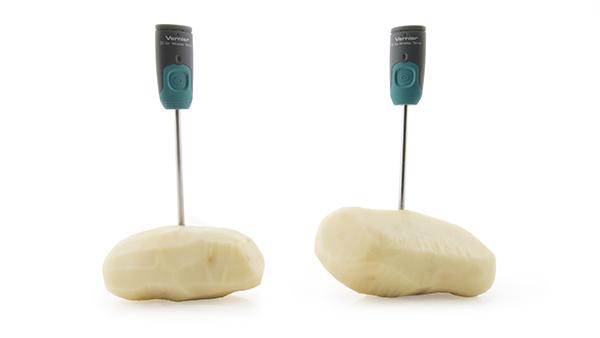
Have you ever sat down to Thanksgiving dinner only to find that the potatoes have gotten cold while everything else was prepared? Does the size of the potatoes affect how long they stay hot? In this investigation, you will compare the rate of cooling of small and large potatoes after they are removed from boiling water. Peel one large and one small potato and place them in boiling water on the stove. Allow them to cook in the boiling water for 30 minutes.
Meanwhile, connect two Go Wireless® Temp probes to LabQuest 2 using the instructions below.
Collecting Data with LabQuest 2 App
-
Choose New from the File menu.
-
On the Meter screen, choose Go Wireless Setup from the Sensors menu.
-
Select Go Wireless Temp from the list of available sensors. When paired with the software, the LED on Go Wireless Temp will flash green.
-
Repeat Steps 2 and 3 for the second Go Wireless Temp.
-
Set the data collection rate to 1 sample/minute and the experiment length to 45 minutes.
Note: If using our Graphical Analysis app for iOS or Android, only one potato can be sampled at a time.
Record the room temperature displayed in LabQuest App. Carefully remove the potatoes from the water. Caution: The potatoes will be very hot! Place a Go Wireless Temp into each of the potatoes so that the tip of the probe is close to the center of the potato. Start data collection and allow the potatoes to cool for 45 minutes. Once data collection is finished, a graph of the temperatures of the cooling potatoes will be displayed.
Examine the graph.
- Which potato cooled at a faster rate?
- What is the relationship between the surface area of the potato and the rate at which it cools?
OPTIONAL: Determine the cooling rate of each of the potatoes mathematically.
Examine the graph to determine the change in temperature during the first minute. Express the rate in ℃/min. Repeat the process to determine the cooling rate during minute 5, minute 10, minute 15, minute 20, minute 25, minute 30, minute 35, and minute 40. Record the data in a table. Repeat for the other potato.
- Which potato had a faster cooling rate in minute 5?
- What happened to the cooling rates of both potatoes as time progressed?
- What is the relationship between temperature and cooling rate?
